| Early
Attitudes in Bouldering Top Ropes, Pads, Buildering & Slacklining |
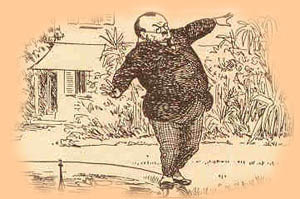 |
|
Reflections & Commentary:
Page 5
|
| Early
Attitudes in Bouldering Top Ropes, Pads, Buildering & Slacklining |
 |
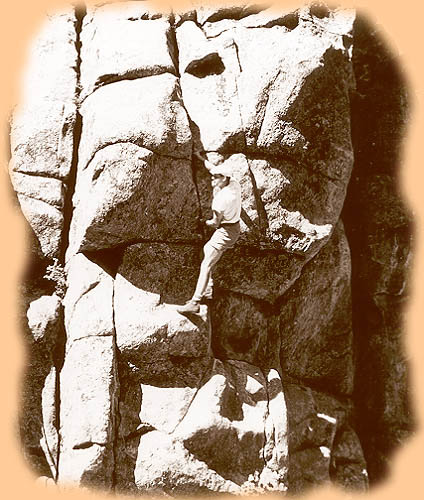 Bouldering on the Final Exam 1966 |
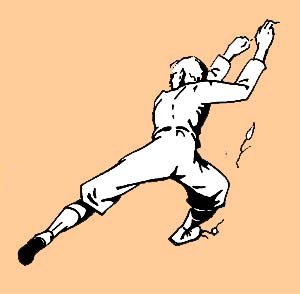 German Climber 1931 |
| Early Attitudes in Bouldering . . . In those early days of American bouldering, only a few took the sport seriously enough to spend considerable time at it. We thought a problem to be of bouldering quality if it seemed harder than what we had climbed with ropes and pitons and took a number of tries to do. However, the idea of working for weeks or months on a single move or short set of moves seemed - at that time - a bit pathological. Exploration was a big part of the sport then. If I couldn't do a problem on the first or (rarely) second visit, I usually moved on to other new climbs. Consequently, many of my “classic” problems are only moderately difficult. For instance, I did the three popular basic routes on the Mental Block at Horsetooth one cold, wintry afternoon in 1967, including the Pinch Overhang , seen here on the FA. I'm wearing the old RD's. Personally, I felt that the elegance of one's performance counted equally as much as the difficulty of the problem. If you are a young boulderer, does this make any sense to you? If I couldn't do a route gracefully I didn't think of it as being properly done. If I were to climb two problems, one moderately difficult done smoothly, and the other more difficult done desperately, I would value the former over the latter. I rarely put a premium on doing a problem the first attempt, although others sometimes disagreed. I thought it more important to make an ascent smoothly if I could, and sometimes this meant playing around on the holds a bit before I got serious. In my book gracefulness trumped number of tries - or even efficiency - which put me at odds with the movement towards more measurable or formal competition. A movement that ultimately prevailed. We may have had more of a sense of humor in those long-ago days before ratings and rankings took hold. No-hands problems were fairly popular, and one-arm problems were not unknown. Here is a photo from the early 1960s of the late Bill Feuerer ("the Dolt") as he won a contest to see who could carry the largest rock up Boulder One at Stoney Point ! (courtesy B.Kamps). And here Michael Fain uses his engineering instincts to get up a slippery problem at Devils Lake in the mid 1950s! |
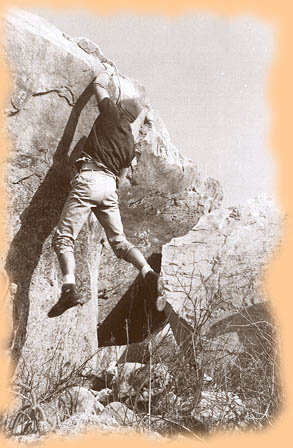 Pinch Overhang: FA, 1967 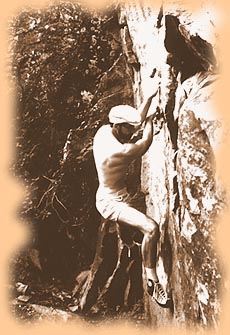 Ripper Area, 1970s - wearing PA's |
| Pads and Ropes . . . In the 1950s and 1960s we didn't have bouldering crash-pads. Sometimes we'd take along a small piece of carpet to stand on before starting a move, just to keep our feet clean. The French used these at 'Bleau in the 1930s, but we didn't know that. If a problem was high or otherwise dangerous, we put up a top-rope more often than not. This practice, also, was consistent with the Bleausards'. It never occured to me to put a cushioned device below a climb, although it certainly would have made solitary bouldering a bit less intimidating. The expression "spotting" comes from gymnastics, but I didn't think of using gym pads for bouldering - they were too heavy and bulky in those days to carry around. If I wanted to experience the risk associated with a higher problem - and I did at times, though infrequently - I would climb it without any protective devices. If I wanted to play around safely, I'd take a top-rope. We didn't do sit-starts, so the obvious advantage of a pad in that instance didn't register. These days, the use of pads on higher problems allows climbers to experience various degrees of partial-risk : do I use no pad? one pad? or several stacked pads? Just one more dimension of complexity in a sport conceived as an exercise in simplicity. [In a recent interview Yvon Chouinard states that bouldering and sport climbing are not real forms of climbing, for they lack risk . That was certainly true of the short problems he and I did at Jenny Lake in the late 1950s, but it doesn't reflect the reality of current bouldering practices. Which is not to say I recommend or condone the search for danger in our sport. In fact, I originally perceived bouldering as being a relatively safe activity - the distilled essence of the climbing experience, free of extensive paraphernalia and practiced close to the ground. (By the way, Yvon continues, admitting he broke his elbow bouldering a few years ago - guess it does get a bit risky!)] |
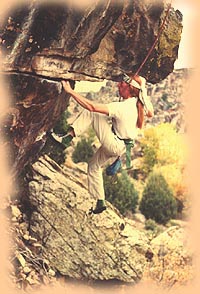 Jim Michaels trying the Juggernaut, Pueblo 1970s |
Top-Ropes & Bouldering . . . There is some discussion currently about the distinctions between bouldering and top-roping. Many climbers view bouldering as strictly a rope–free activity with any safety measures confined to pads and spotters. Indeed, this is one way to adequately distinguish between bouldering and other forms of climbing, except for free-soloing. Then the question is: 'how high must a boulder problem be before it's free-soloing?'. One way to avoid answering this is to perceive bouldering and free-soloing as simply manifestations of a continuum of "3rd class" climbing. (Or, when your stack of pads looks smaller than a postage stamp, you're free-soloing!) Generally, pads give less protection than a top-rope, providing to some climbers yet one more nuance of competitive superiority. Others view top-roping as a reasonable and legitimate method of protection on a problem with a dangerous landing. As I have previously stated, when I did most of my bouldering, in the late 1950s through the 1970s, I used top-ropes sometimes and at other times avoided any type of protection. Top-roping was acceptable for most climbers who bouldered - until the relatively recent introduction of pads. (Don't underestimate the commercial aspect of this dialogue: pad manufacturers these days might not be pleased if more climbers decided that top-ropes are not unethical.) "Once I was standing at the foot of a small though difficult problem, and Dunderhead was aloft, having walked around by some grass, and I was just stepping delicately up onto the first foothold, steadying myself lightly with my hands, when there was a pull, and I was jerked violently against the rocks flattening my nose, and knocking the skin off my chin and fingers, all through the officious stupidity of my retainer. And as that man was, so will most of his kind be. Wherefore, take care." Don't be reluctant to put on a rope if you think you may come off from more than a few feet above the ground - thirty or forty years from now your back, knees, ankles, and feet will thank you . . . If I were still active, I would see the situation in the following way: If you want nothing to do with ropes, then call your activity free-bouldering or just bouldering. (If you are a real purist and eschew pads as well, call it ultrafree-bouldering !). If you prefer top-ropes over pads, then admit you are rope-bouldering. Questions relating to the 'ethical' solutions of a particular problem can be somewhat clarified with this terminology. For instance, when I first climbed the Left Eliminator at Horsetooth in 1967 or thereabouts, it was the first rope-bouldering ascent. Later, I did the first free-bouldering ascent. In other instances climber A may do the first rope-bouldering ascent and climber B the first free-bouldering ascent. Thus, the distinction is there for those who want there to be one - for others it's immaterial. However, I acknowledge the fact that most boulderers today use only crash pads and feel that putting on a top-rope is unethical. This actually opens the door to a separate specialty: a modern version of top-roping that can be quite challenging. |
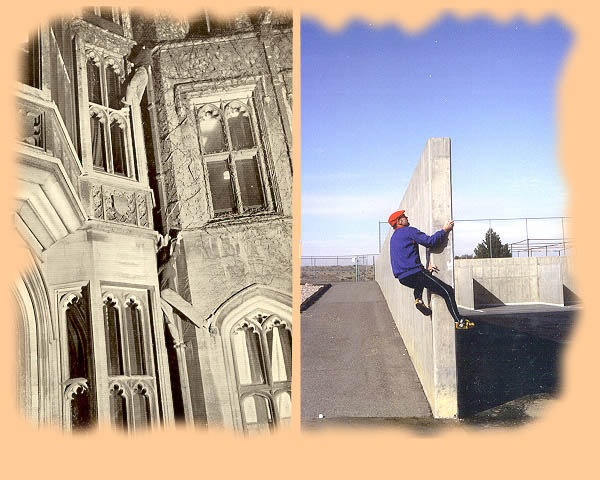 |
|
Here are two contrasting photos: a historical one of climbers at Cambridge in the mid 1930s (The Night Climbers of Cambridge by "Whipplesnaith" - N. H. Symington) climbing the ornate facade of an ancient campus building, and the other of me on the modern campus of Colorado State University at Pueblo in the mid 1990s, climbing a smooth cement rib with beveled edges.
These are two instances, separated by about 60 years, in which the climbers of each era - according to the perspectives of those times - may be said to be engaging in "gymnastic climbing". |
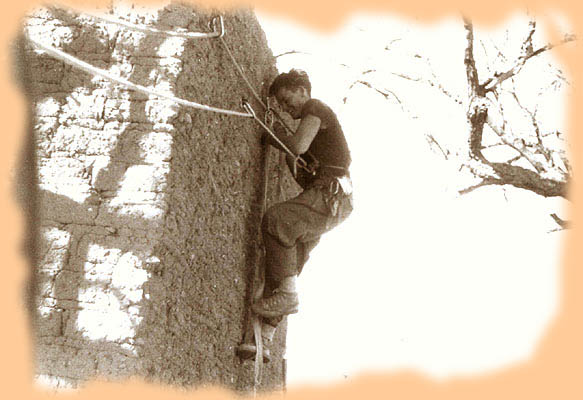 |
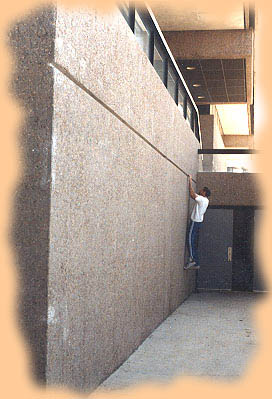 |
| Lest you think all buildering in the 1950s was free climbing, here's a shot of a youthful Dave Rearick as he does a aid traverse on an old adobe wall in Arizona in 1958 (Courtesy B.Kamps) . And, to the right, a shot of me doing a lengthy traverse on the campus of CSU at Pueblo in 1980 |
Wires, Chains, & Beer
Bottles: the Precursors of Slacklining . . .
Slacklining, walking across a nylon webbing or rope stretched between two supports, is a fairly recent off-shoot of rock climbing having its own aggregate of devotees. Currently, its most stimulating and challenging format is a line strung across an abyss, fastened to rock supports on either side. A safety cord, attached by carabiner, sliding along the line behind the walker, provides a thrilling form of security. Occasionally, bravado severely exceeds caution (and good sense) and the walker avoids hooking up. The origins of this sort of balancing act go far back in history to daredevils like Ivy Baldwin, who walked a tightwire, unprotected, across Eldorado Canyon near Boulder in 1907. Ivy carried a balancing pole (more appropriate for a tightwire), which slackliners avoid. Rope Dancers amused audiences during the age of Rome. . . During the 1950s and 1960s, I would frequently take a 30 foot length of light chain with me when I toured the climbing campgrounds in the Black Hills and Tetons, suspending it between two trees a few feet off the ground, and diverting climbers from their stated goals to play a balancing game. Pat Ament walked chain in Colorado in the 1960s, as well. In Yosemite, a youthful Chuck Pratt delighted in lining up a row of empty beer bottles on a flat surface and gently creeping from one end to the other. Over the passage of years it seemed inevitable that as fragmentation of the focal sport of rock climbing proceeded, there would appear a group whose central interest would evolve about what had been a form of practice, much as bouldering parted company from traditional rock climbing. Go to slackline.com to learn more about this exciting game, which had its modern origins about 17 years ago. |